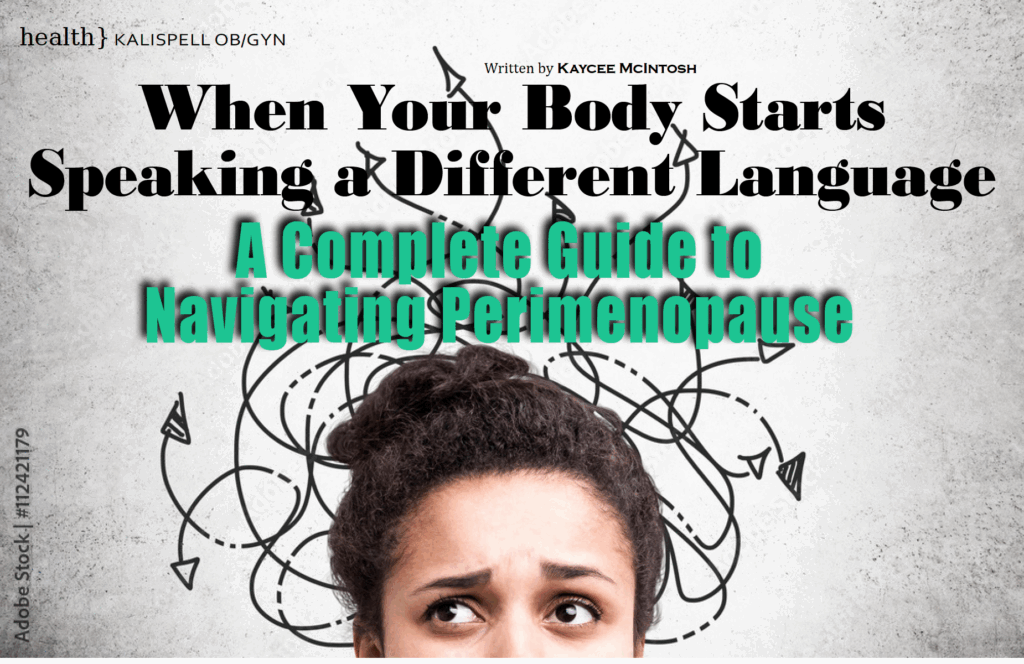A Complete Guide to Navigating Perimenopause

You’re juggling work deadlines, driving kids to soccer practice, and helping your aging parents navigate Medicare decisions when it hits: a wave of heat that makes you want to rip off your blazer in the middle of that important client meeting. Co-workers might be freezing next to you as you blast the air conditioner into your workspace as you try to cool yourself down. Later that night, you wake up drenched in sweat, sheets soaked, wondering if the air conditioning broke. By morning, you’re snapping at your teenager over toast crumbs, feeling exhausted before the day even begins.
Sound familiar?
If you’re in your 40s experiencing these changes, you’re not losing your mind or falling apart. You’re likely entering perimenopause – a natural transition that affects virtually every woman yet somehow remains one of our best-kept secrets.
Recent research involving nearly half a million women reveals that 65% experience joint and muscle discomfort, 64% report physical exhaustion, and over half deal with sleep problems and irritability (BMC Public Health, 2024). Yet many of us initially attribute these symptoms to stress, aging, or just being “too busy.” The truth is that your hormones are shifting and understanding what’s happening can be the first step toward feeling like yourself again.
Your hormones are on a rollercoaster ride
The changes you’re experiencing aren’t random – they follow a predictable pattern rooted in biology. The first culprit is actually progesterone, not estrogen as many people think (NCBI StatPearls, 2024). Progesterone levels begin declining around age 35, often years before your periods become irregular. This hormone acts like your body’s natural chill pill – it calms anxiety, promotes restful sleep, and keeps your mood stable through its effects on brain chemistry.
As progesterone drops, you lose this built-in stress buffer, which explains why you might find yourself having less patience with everyday annoyances or feeling more anxious than usual. Meanwhile, estrogen levels don’t just decline – they fluctuate wildly, sometimes spiking higher than normal before crashing down.
These estrogen roller coasters directly affect the temperature control center in your brain, triggering those infamous hot flashes and night sweats. The vaginal dryness that 37% of women experience happens because estrogen receptors in vaginal tissue aren’t getting their usual hormonal signals (BMC Public Health, 2024).
Skip the blood test – your symptoms tell the story
Here’s something that might surprise you: your doctor probably doesn’t need to test your hormone levels to diagnose perimenopause (American College of Obstetricians and Gynecologists). The reason relates directly to what we just discussed about hormone fluctuations.
Hormone levels during perimenopause change so dramatically from week to week – even day to day – that a single test can’t capture what’s really happening (NCBI StatPearls, 2024). Your estrogen might be sky-high on Tuesday and in the basement by Friday. Your symptoms, combined with your age and menstrual pattern changes, paint a much clearer picture than any blood test can provide. The way I like to describe this is that finding useful information on a hormone test is like trying to hit a moving target while blindfolded. That’s why we won’t use this information to make treatment decisions. Instead, if you are symptomatic, we use that as our guide. If we start treating you and you begin feeling better, we know we’re on the right path.
The idea that you should just “tough it out” until menopause is outdated and unnecessary and could have some unintended consequences in your personal life.
The hormone therapy landscape has changed
If you’re hesitant about hormone replacement therapy, you’re not alone. The 2002 Women’s Health Initiative study created widespread fear about HRT, but subsequent analysis shows the results were misinterpreted and overgeneralized (Circulation, 2023). The study focused on older women (average age 63) taking specific hormone formulations that aren’t representative of how HRT is typically used today.
The 20-year follow-up data from the WHI, published in 2020, revealed important distinctions between different types of hormone therapy. Women taking estrogen alone (only possible for those who had hysterectomies) actually had a 23% reduction in breast cancer incidence and 40% reduction in breast cancer deaths (JAMA, 2020). In contrast, women taking combined estrogen-plus-progesterone therapy (needed for those with intact uteruses) did show increased breast cancer incidence, but importantly, no increase in breast cancer deaths (JAMA, 2020).
Current medical understanding emphasizes the “timing hypothesis” – HRT benefits significantly outweigh risks when started within 10 years of menopause or before age 60 (Circulation, 2023).
Let’s talk numbers – putting risk in perspective
The breast cancer statistics that often scare women deserve context. Combined hormone therapy (estrogen plus progesterone) increases relative breast cancer risk by about 24% (NCBI StatPearls, 2024) – but the absolute risk remains small. Over five years of use, this translates to approximately one additional breast cancer case per 50-70 users.
Here’s where the alcohol comparison becomes eye-opening: moderate alcohol consumption (7-10 drinks weekly) increases breast cancer risk by 20-30% – comparable to HRT (Susan G. Komen Foundation, 2024). But here’s the critical finding that many women don’t know: HRT and alcohol together create a synergistic effect (ScienceDirect, 1999). Women using HRT who consume alcohol regularly have significantly higher breast cancer risk than those who do either alone.
The takeaway isn’t necessarily to avoid HRT, but rather to understand that if you choose hormone therapy, minimizing alcohol consumption becomes particularly important.
Delivery method matters for safety
If you’re considering HRT, how you take it matters enormously for safety. Transdermal estrogen (patches, gels, or sprays) doesn’t increase blood clot or stroke risk, while oral estrogen carries a measurable increase in both (PubMed, 2010; ACOG, 2013). For women with an intact uterus, adding progesterone is essential to prevent overgrowth of the uterine lining, which increases uterine cancer risk (US Pharmacist, 2024). As a provider, we will always discuss risks and encourage patients to choose formulations that will reduce risk the most.
If we start treating you and you begin feeling better, we know we’re on the right path.
Beyond hormones – effective alternatives exist
If you are concerned about increased risks associated with hormone therapy, or if you are already at elevated risk, there are still non hormonal therapies that can help you feel more like yourself and help curb irritability and reduce hot flashes.
Antidepressants serve as evidence-based first-line alternatives, with medications like venlafaxine, paroxetine, and escitalopram reducing hot flash frequency by 45-64% (US Pharmacist, 2024). These work by modulating brain chemistry involved in temperature regulation, not because perimenopause is a mental health problem.
The newest player is Veozah (fezolinetant), a non-hormonal medication specifically designed for menopausal hot flashes (PMC, 2023). Approved in 2023, it blocks certain receptors in the brain’s temperature control center, providing 57% reduction in hot flash frequency. It’s particularly valuable for women with breast cancer history, though it requires liver function monitoring due to rare but serious liver injury risk (FDA, 2024). Also, this medication can be difficult to get insurance coverage, unless you have history of breast cancer or high risk of breast cancer.
Vaginal dryness can be addressed separately from systemic symptoms using low-dose vaginal estrogen preparations with minimal systemic absorption, and this can be an option for people even at higher baseline risk for breast cancer since the estrogen largely remains local (US Pharmacist, 2024).
Lifestyle strategies that work
Regular exercise – particularly the combination of aerobic activity and resistance training – supports bone health, mood, and sleep quality (BioMed Central, 2024). A Mediterranean dietary pattern is associated with reduced symptom burden (PMC, 2024). Managing the lifestyle factors that interact with hormonal changes becomes crucial during perimenopause (Australasian Menopause Society, 2024). Ultimately, stay active and prioritize self care and nutrition.
You don’t have to wait until menopause
You don’t need to suffer through years of symptoms waiting to reach official menopause (defined as 12 months without periods). Perimenopause can last 4-8 years, and effective treatments are available throughout this transition (MDPI, 2024). The idea that you should just “tough it out” until menopause is outdated and unnecessary and could have some unintended consequences in your personal life.
Your next steps – you’re not alone in this
This transition affects virtually all women, yet many of us navigate it feeling isolated and uninformed, and at times like we are going out of our heads! If these symptoms are affecting your quality of life, work performance, or relationships, it’s time for a conversation with a healthcare provider who understands perimenopause.
The landscape of perimenopause treatment has evolved dramatically, with safer hormone formulations, effective non-hormonal alternatives, and a much more nuanced understanding of individual risk factors. The goal is the same: helping you feel like yourself again.
It’s worth mentioning that there are many supplement companies touting cures for hot flashes and perimenopausal symptoms, but we strongly recommend talking to a licensed healthcare provider rather than going that route. These “treatments” are not FDA-regulated for safety or efficacy, and some can interact with other medications or have unintended side effects.
Schedule that appointment
Ask specific questions about your symptoms. Discuss your family history, lifestyle factors, and treatment preferences. Most importantly, know that feeling better is possible, you’re not imagining these changes, and you absolutely don’t have to suffer in silence.
With the right information and support, this transition can be the beginning of a new chapter where you feel informed, empowered, and in control of your health decisions.
Kaycee McIntosh is a Physician Assistant at Kalispell OB/GYN and fifth-generation Montanan on both sides of her family. She was born in Missoula and raised in the Flathead Valley when at the age of 4, she and her family moved to Whitefish so her father could work on the railroad. Kaycee went to college in Bozeman where she received a Bachelor of Science degree in Exercise Science/Health and Human Development from MSU. She then went to graduate school at Rocky Mountain College in Billings where she received her Master of Physician Assistant.
She worked in Urgent Care for Logan Health for ten years, where she gained valuable experience in many areas of medicine before transitioning into women’s health at Kalispell OB/GYN at the end of 2021. Kaycee enjoys the entire
This articles appears in the current issue of 406 Woman Magazine
